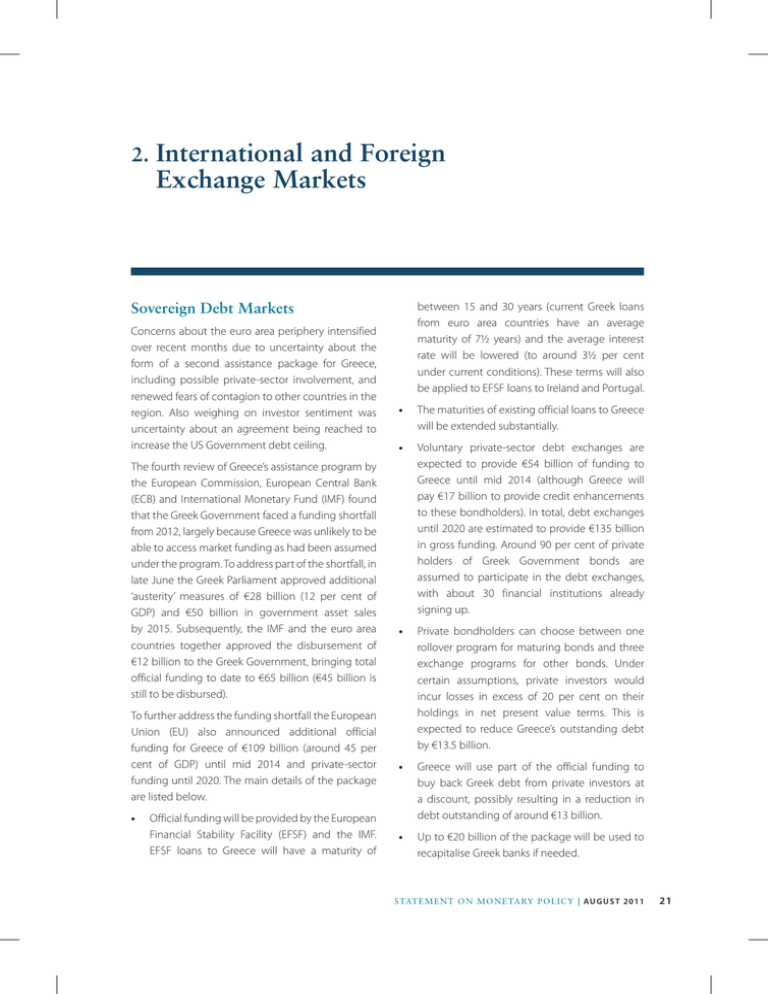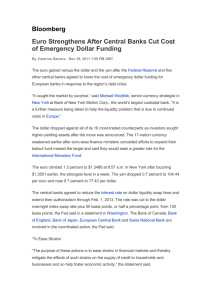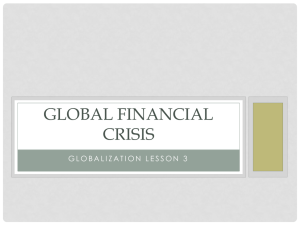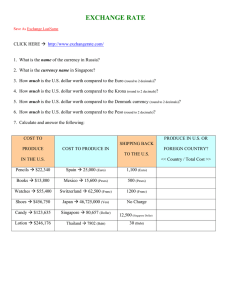International and Foreign Exchange Markets 2. Sovereign Debt Markets
advertisement

2. I nternational and Foreign Exchange Markets Sovereign Debt Markets Concerns about the euro area periphery intensified over recent months due to uncertainty about the form of a second assistance package for Greece, including possible private-sector involvement, and renewed fears of contagion to other countries in the region. Also weighing on investor sentiment was uncertainty about an agreement being reached to increase the US Government debt ceiling. The fourth review of Greece’s assistance program by the European Commission, European Central Bank (ECB) and International Monetary Fund (IMF) found that the Greek Government faced a funding shortfall from 2012, largely because Greece was unlikely to be able to access market funding as had been assumed under the program. To address part of the shortfall, in late June the Greek Parliament approved additional ‘austerity’ measures of €28 billion (12 per cent of GDP) and €50 billion in government asset sales by 2015. Subsequently, the IMF and the euro area countries together approved the disbursement of €12 billion to the Greek Government, bringing total official funding to date to €65 billion (€45 billion is still to be disbursed). To further address the funding shortfall the European Union (EU) also announced additional official funding for Greece of €109 billion (around 45 per cent of GDP) until mid 2014 and private-sector funding until 2020. The main details of the package are listed below. •• Official funding will be provided by the European Financial Stability Facility (EFSF) and the IMF. EFSF loans to Greece will have a maturity of between 15 and 30 years (current Greek loans from euro area countries have an average maturity of 7½ years) and the average interest rate will be lowered (to around 3½ per cent under current conditions). These terms will also be applied to EFSF loans to Ireland and Portugal. •• The maturities of existing official loans to Greece will be extended substantially. •• Voluntary private-sector debt exchanges are expected to provide €54 billion of funding to Greece until mid 2014 (although Greece will pay €17 billion to provide credit enhancements to these bondholders). In total, debt exchanges until 2020 are estimated to provide €135 billion in gross funding. Around 90 per cent of private holders of Greek Government bonds are assumed to participate in the debt exchanges, with about 30 financial institutions already signing up. •• Private bondholders can choose between one rollover program for maturing bonds and three exchange programs for other bonds. Under certain assumptions, private investors would incur losses in excess of 20 per cent on their holdings in net present value terms. This is expected to reduce Greece’s outstanding debt by €13.5 billion. •• Greece will use part of the official funding to buy back Greek debt from private investors at a discount, possibly resulting in a reduction in debt outstanding of around €13 billion. •• Up to €20 billion of the package will be used to recapitalise Greek banks if needed. STATE ME N T O N MO N E TARY P O L ICY | Au g u s t 2 0 1 1 21 Graph 2.1 Stability Mechanism (ESM), will be expanded, allowing them to: European Government Bond Spreads To 10-year German Bunds Bps Bps act on the basis of a precautionary program prior to official EU/IMF assistance; •• finance banking system recapitalisations; and •• purchase sovereign debt on secondary markets. 1 000 1 000 800 800 Ireland 600 600 Portugal 400 400 Belgium Italy France 200 200 Spain l 0 0 l 2010 2011 2011 2010 Source: Bloomberg Graph 2.2 10-year Government Bond Yields % % 14 14 12 12 10 10 Ireland 8 8 Portugal 6 6 4 4 Italy Spain 2 0 1995 l l l l l 1999 l l l l l 2003 l l 2 l 2007 l l 0 2011 l Sources: Bloomberg; Thomson Reuters The major rating agencies have said that the package is likely to see Greece’s debt downgraded to default, although possibly only temporarily. During this period, to ensure that Greek banks can continue to use Greek sovereign bonds as collateral to borrow from the ECB, euro area governments will indemnify the ECB for losses up to €35 billion on these bonds. The International Swaps and Derivatives Association (ISDA) suggested that a ‘credit event’ on Greek sovereign credit default swaps is unlikely to be declared due to the voluntary nature of the debt exchange. The EU also announced that the flexibility of the EFSF and its replacement in mid 2013, the European 22 •• R es erv e B a n k o f Aus t r a l i a These measures could apply to countries not under formal assistance programs. European authorities had previously announced that ESM loans provided to Greece, Ireland and Portugal will not have preferred creditor status. All other bailout loans, however, will have preferred creditor status. Mainly reflecting the Greek concerns, spreads between yields on German Bunds and other euro area sovereign bonds, including those of France and Belgium, widened to their highest levels since at least the adoption of the euro in 1999 (Graph 2.1). Italian and Spanish 10-year bond yields rose to more than 6 per cent, their highest levels since 1997 (Graph 2.2). Standard & Poor’s (S&P) and Moody’s placed Italy’s credit rating on review for possible downgrade, while Italy’s Parliament passed ‘austerity’ measures of €48 billion (3 per cent of GDP), taking effect mainly in 2013 and 2014. Moody’s also downgraded the credit ratings of Ireland and Portugal to below investment grade, citing a growing risk that, given developments in Greece, both countries will require a second round of official financing, which would increase the likelihood that private-sector creditor participation will be required. Reflecting the increased risk aversion due to uncertainty about Greece, together with softer economic data, sovereign bond yields in the major advanced economies have declined in recent months. Notwithstanding the uncertainty about whether an agreement would be reached to increase the US Government debt ceiling, US and German 10-year government bond yields reached their lowest levels since November 2010 and the UK 10-year bond yield reached a multi-decade low (Graph 2.3). The 2-year US Treasury yield reached a record low in early August. Graph 2.3 Graph 2.4 US Dollar-denominated Sovereign Debt Spreads 10-year Government Bond Yields % % 5 Emerging Asia Emerging Europe Latin America Bps 5 1 000 UK 4 4 3 3 2 To US government bonds, duration matched Bps US Germany 2 1 1 Japan 0 l 2008 l 2009 l 2010 2011 0 Source: Bloomberg 1 000 800 800 600 600 400 400 200 200 0 l l 2009 l l 2011 l 2009 l l 2011 l 2009 0 l 2011 Source: Thomson Reuters In July, Moody’s and S&P placed the US credit rating on review for possible downgrade as concerns about raising the US Government debt ceiling intensified. An increase in the debt ceiling of at least US$2.1 trillion over the next couple of years was approved on 2 August. Spending cuts of US$0.9 trillion were also agreed, with a joint committee formed to identify a further US$1.2 to US$1.5 trillion in spending cuts or additional revenue. Following the increase in the debt ceiling, Moody’s reaffirmed the US AAA credit rating but placed it on negative outlook. Fitch and S&P are still reviewing the US credit rating. Despite the increased risk aversion, spreads on US dollar-denominated debt issued by sovereigns in emerging Asia and Latin America were little changed in recent months (Graph 2.4). However, spreads on emerging European sovereign debt widened but remain below levels reached during the initial Greek debt crisis in May 2010. Central Bank Policy Monetary policy tightening has continued in a number of economies over recent months (Table 2.1). The ECB increased its policy rate by 25 basis points to 1.50 per cent in July, following a similar increase in April. Amid concerns about the euro area periphery, however, financial markets have pushed back expectations of further ECB policy tightening until at least the second half of 2012. Reflecting weaker economic data, there is no expectation of policy rate tightening in the United States and the United Kingdom in the period ahead. The People’s Bank of China raised its benchmark interest rates by 25 basis points in July and further increased banks’ reserve requirement ratios. Policy rates were also increased in Brazil, India, Israel, Malaysia, Norway, South Korea, Sweden, Taiwan and Thailand. In contrast, in response to the significant appreciation of the Swiss franc, the Swiss National Bank lowered its policy rate target to close to 0 per cent, and announced that it will substantially increase Swiss franc liquidity. On 4 August, the Bank of Japan announced further monetary easing through an increase of ¥5 trillion in its Asset Purchase Program to ¥15 trillion and a ¥5 trillion increase in its fixedrate liquidity-providing operations to ¥35 trillion. At the same time the Japanese authorities intervened to weaken the yen. The US Federal Reserve completed its second round of large-scale asset purchases at the end of June, increasing its holdings of US Treasuries by US$600 billion (Graph 2.5). The Fed will maintain the size of its aggregate securities holdings for some time by reinvesting principal payments on these holdings in US Treasuries. The Fed also outlined principles to STATE ME N T O N MO N E TARY P O L ICY | Au g u s t 2 0 1 1 23 Table 2.1: Policy Rates Current level Per cent Most recent change Cumulative increase Basis points Euro area 1.50 ↑ Jul 11 50 Japan 0.05 ↓ Oct 10 – United States 0.125 ↓ Dec 08 – Brazil 12.50 ↑ Jul 11 375 Canada 1.00 ↑ Sep 10 75 China 6.56 ↑ Jul 11 125 India 8.00 ↑ Jul 11 325 Indonesia 6.75 ↑ Feb 11 25 Israel 3.25 ↑ May 11 275 Malaysia 3.00 ↑ May 11 100 Mexico 4.50 ↓ Jul 09 – New Zealand 2.50 ↓ Mar 11 – Norway 2.25 ↑ May 11 100 Russia 8.25 ↑ Apr 11 50 South Africa 5.50 ↓ Nov 10 – South Korea 3.25 ↑ Jun 11 125 Sweden 2.00 ↑ Jul 11 175 Switzerland 0.00 ↓ Aug 11 – 1.875 ↑ Jun 11 63 Thailand 3.25 ↑ Jul 11 200 Turkey 6.25 ↓ Jan 11 – United Kingdom 0.50 ↓ Mar 09 – Taiwan Source: central banks Graph 2.5 Federal Reserve Holdings of Securities Weekly US$b 2 500 US$b n Agency MBS n Agency debt n US Treasuries 2 500 2 000 2 000 1 500 1 500 1 000 1 000 500 500 0 l 2008 l 2009 Source: Board of Governors of the Federal Reserve System 24 0 l 2010 R es erv e B a n k o f Aus t r a l i a 2011 guide its stance on normalising monetary policy. The first step would be to stop reinvesting principal payments in US Treasuries, with actual sales of securities not commencing until after the Fed begins increasing its policy rate. Once sales commence, the Fed expects that all holdings of agency securities will be sold within three to five years. The ECB’s balance sheet has been broadly unchanged over the past year. Despite the turmoil in the euro area periphery, the ECB has not purchased government securities since late March. Total lending to banks via its monetary policy operations has increased in recent months, with lending to peripheral euro area banks Graph 2.6 Graph 2.7 ECB Lending to Banks* Domestic Private Deposits Held at Greek Banks Monthly By national central bank €b €b €b Fixed-rate tenders from October 2008 onwards Ireland Spain 120 120 80 220 220 190 190 160 160 130 130 80 Greece 40 40 Italy Portugal 0 0 2007 2008 2009 2010 2011 * Lending provided through monetary policy operations only Source: central banks remaining elevated (Graph 2.6). While ECB lending to Irish banks, including through emergency loans, has fallen, this has been largely offset by funding from the Irish Government, reflecting funds received under the financial assistance package. The recent increase in liquidity to Greek banks has been to offset a sharp decline in deposit funding. At end May, Greek banks’ domestic private-sector deposits were around €45 billion (19 per cent) lower than at the end of 2009 (Graph 2.7). The rate of deposit outflow in Greece has far exceeded that in Ireland and Portugal. Financial Regulation and Policy The European Banking Authority (EBA) released the results of its EU-wide bank stress tests in mid July. Under the two-year stress scenario, the 90 banks publishing results would incur losses estimated to be €471 billion (almost half of end-2010 core Tier 1 capital). When estimating capital positions under the stress scenario, the EBA allowed banks to include capital raisings and other measures announced up to 30 April 2011. Eight banks (five Spanish, two Greek and one Austrian) had stressed core Tier 1 capital ratios of less than the 5 per cent benchmark, with the aggregate capital shortfall of these banks being €2.5 billion. One German bank that pulled out of the stress tests also would have ‘failed’. A further 16 banks had core Tier 1 capital 100 2005 Source: Bank of Greece 2007 2009 2011 100 ratios of between 5 and 6 per cent under the stress scenario. If announced capital raisings up to end April 2011 were excluded, 20 banks would have fallen below the 5 per cent capital threshold, with an overall capital shortfall of around €27 billion. The EBA recommended that national banking supervisors ensure that banks ‘failing’ the stress tests present plans within three months to remedy the shortfalls and implement these plans by the end of this year. Following the release of the stress test results, national supervisors of the failing banks indicated that these institutions would have core Tier 1 capital ratios well above 5 per cent under the stress scenario after including all additional mitigating actions taken or planned since end April, as well as other mitigating measures not recognised by the EBA. The EBA also encouraged supervisors to request all banks that only just ‘passed’ the stress tests, and have sizeable exposures to sovereigns under stress, to strengthen their capital positions by April 2012. The stress tests did not allow for sovereign defaults but sovereign stress was included in the form of haircuts applied to sovereign debt held on banks’ trading books. Banks also had to ensure that their provisions for sovereign debt held on their banking books met a floor based on conservative estimates of default probabilities and loss given STATE ME N T O N MO N E TARY P O L ICY | Au g u s t 2 0 1 1 25 Graph 2.8 US Dollar Funding Costs 3-month maturity Bps Bps Forward spread to OIS* 60 60 45 45 30 30 15 15 0 0 EUR/USD basis swap -15 l D 2009 l l M J l l S D l l M J 2011 2010 S Credit Markets Graph 2.9 US Prime Money Market Fund Assets Institutional funds only US$b US$b 1 300 1 300 1 200 1 200 1 100 1 100 1 000 1 000 l 2008 l 2009 l 2010 2011 900 Source: Investment Company Institute default. In addition, the EBA published detailed exposures of participating banks to peripheral euro area government debt in order to allow market participants to conduct their own analysis. In the United States, several financial institutions have been involved in legal action or investigations by authorities. Bank of America has offered to pay around US$8.5 billion to settle lawsuits relating to mortgage-backed securities issued by Countrywide Financial, which it purchased in 2008. The proposed settlement was agreed with the trustee and 22 investors, including the Federal Reserve Bank of New York. It requires court approval and has been challenged by other investors. Several other 26 R es erv e B a n k o f Aus t r a l i a Regulatory reforms regarding the standardisation and central clearing of derivatives contracts under the Dodd-Frank Wall Street Reform and Consumer Protection Act were postponed for six months, as new regulations had yet to be finalised approaching a 16 July deadline. Concerns had arisen about the enforceability of existing contracts had the new rules become legally binding before being sufficiently well-defined. -15 * Expectations of 3-month LIBOR/OIS spread in three months time Source: Bloomberg 900 financial institutions are either under investigation, being sued or have reached settlements with authorities on mortgage-related matters. Reflecting the increased tensions in financial markets, there has been some increase in the cost of US dollar funds (Graph 2.8). In the interbank lending market this has been reflected in higher spreads between US dollar forward rates and overnight indexed swaps (OIS), while in foreign exchange markets it can be seen in a higher cost – the ‘basis’ – to swap euros into US dollars. US dollar funding pressures, however, remain considerably less than in 2008. US ‘prime’ institutional money market funds, which are significant providers of short-term US dollar funding to European banks, have experienced significant investor outflows since the end of May (Graph 2.9). These outflows have been faster than in the lead up to the Greek debt crisis in May 2010 but significantly smaller than those following the collapse of Lehman Brothers in September 2008. US money market funds had already reduced their holdings of debt issued by banks in Greece, Ireland, Italy, Portugal and Spain to zero or very small amounts. Money market funds have also recently been reducing and/or shortening their exposures to banks in other euro area countries. Regulatory changes since the financial crisis, however, including shortening the average maturity of funds’ assets and requiring greater daily liquidity, should help to reduce the risk of indiscriminate selling of assets by US money market funds if the rate of investor outflows were to increase. Graph 2.10 Equities Corporate Bond Spreads To equivalent government bonds Bps US Bps Euro area 2 500 2 500 ‘Junk’ B 2 000 2 000 1 500 1 500 Global equity prices have exhibited several sharp swings since the beginning of the year and in net terms have fallen over this period, reflecting soft economic data and sovereign debt concerns (Table 2.2, Graph 2.12). Euro area equity markets have significantly underperformed other major equity markets. Financials 1 000 1 000 500 0 500 AA* l 2007 l Per cent l 2009 Table 2.2: Changes in International Share Prices l l 2011 l l 2009 l 2011 0 * Non-financial corporates Sources: Bank of America Merrill Lynch; Bloomberg; RBA Graph 2.11 Since end 2010 Since previous Statement United States Corporate Bond Issuance US$b – Dow Jones 3 –7 200 200 – S&P 500 0 –6 150 150 – NASDAQ 2 –5 100 100 Euro area 50 50 – STOXX –11 –15 – FTSE –5 –7 Japan US$b US$b US Euro area US$b United Kingdom 200 200 150 150 – Nikkei –6 –4 100 100 Canada 50 50 – TSE 300 –5 –6 0 0 Australia – ASX 200 –9 –9 –5 –7 – Emerging Asia –4 –5 – Latin America 2011 2007 2008 2009 2010 n Sub-investment-grade corporates n Covered bonds n Investment-grade corporates n Guaranteed financials n Unguaranteed financials Sources: Dealogic; RBA; Thomson Reuters China – China A Heightened risk aversion has led to a widening in spreads between yields on lower-rated nonfinancial corporate and financial institution bonds and equivalent government bonds over the past few months (Graph 2.10). Reflecting this higher cost and reduced investor risk appetite, corporate bond issuance in the United States and euro area has moderated since May (Graph 2.11). Issuance by euro area financial institutions has been particularly weak relative to the average of the past two years. MSCI indices –16 –8 – Emerging Europe –3 –6 – World –5 –8 Source: Bloomberg Banks’ share prices have declined more than the broader market, particularly in Europe (Graph 2.13). Apart from the ongoing concerns about the effect STATE ME N T O N MO N E TARY P O L ICY | Au g u s t 2 0 1 1 27 Graph 2.12 Major Share Price Indices 1 January 2010 = 100 Index Index S&P 500 120 120 FTSE 110 110 100 100 90 90 Nikkei Euro STOXX 80 M l J l S 2010 l D l M l Source: Bloomberg J 2011 l S 80 Graph 2.13 Banks’ Share Prices Relative to Market 1 January 2010 = 100 Index Index US* 110 110 UK 100 100 90 90 80 80 Euro area 70 70 60 l M l J l S l D l M l J 2011 2010 S 60 * Diversified financials Sources: Bloomberg; RBA Graph 2.14 Local currencies, 1 January 2010 = 100 Index Emerging Asia 120 120 Emerging Europe 100 100 Latin America 80 80 China A 60 l M l J l S l D l M 2010 Sources: Bloomberg; MSCI 28 R es erv e B a n k o f Aus t r a l i a l J 2011 S In the United States, ongoing uncertainty surrounding potential costs associated with banks’ mortgagerelated practices further contributed to weakness in banks’ share prices. Large US bank earnings reported for the June quarter were mostly better than expected. Earnings were generally supported by investment banking revenue, although trading revenues were typically weaker; aggregate loan-loss provisions were unchanged in the quarter. Several banks continued to record large foreclosure and other mortgage-related costs. Most notably, Bank of America reported a large second-quarter net loss, reflecting US$14 billion in provisions for mortgagerelated costs; the bank also recorded around US$6 billion in other mortgage-related charges in the quarter. Equity prices in emerging economies have, in aggregate, largely followed those in advanced economies lower in recent months (Graph 2.14). In emerging Asia and Latin America, actual or expected policy tightening in some economies has contributed to the decline in share prices. Hedge Funds Emerging Market Share Price Indices Index on banks’ profitability from regulatory changes, European banks’ stock prices have fallen because of concerns about their exposures to peripheral euro area economies and generally weaker-thanexpected second-quarter earnings. Moody’s placed several French and Italian banks’ ratings on review for possible downgrade or on negative outlook. 60 Hedge funds returns were significantly lower than for global share markets over the year to June, recording an average investment return of 11½ per cent compared with a return of 22½ per cent for equities. Nevertheless, investor appetite for hedge funds has remained strong and in the first half of the year hedge funds received the largest injection of capital since the second half of 2007. Funds under management now stand at US$2.0 trillion (Graph 2.15). Graph 2.15 The US dollar remained close to historically low levels on a trade-weighted basis, having depreciated by around 7 per cent over the past 12 months (Table 2.3). The US dollar, however, has appreciated moderately against the euro since the previous Statement, as financial stresses in Europe weighed on the euro and were only partly offset by an increase in the ECB’s policy rate. Intraday volatility in the euro remains elevated. Global Hedge Funds US$b US$tr 750 1.8 Total funds under management (RHS) 500 1.2 250 0.6 0 0.0 Returns (LHS) -250 Table 2.3: Changes in the US Dollar against Selected Currencies -0.6 Net investor flows (LHS) -500 -1.2 1991 1995 1999 2003 2007 Per cent Q1Q2 2011 Source: Hedge Fund Research, Inc. Over past year Since previous Statement Swedish krona –10 4 European euro –7 4 South African rand –7 2 Mexican peso –6 2 New Taiwan dollar –9 1 Foreign Exchange Concerns about the European sovereign debt situation and the health of its banking systems dominated developments in the major foreign exchange markets over the past few months. More recently, concerns regarding US public finances and economic performance have weighed on the US dollar. Recurrent swings in risk sentiment and demand for safe-haven currencies meant that it was a volatile period for exchange rates, albeit less volatile than in 2008/09. UK pound sterling Graph 2.16 Swiss Franc Inverted scale CHF CHF 0.90 0.90 Franc per US$ 1.10 1.10 1.30 1.30 1.50 1.50 1.70 1.90 1.70 Franc per euro l 1999 l l l 2002 Source: Bloomberg l l l 2005 l l l 2008 l l 2011 –3 1 –15 1 Canadian dollar –6 1 Malaysian ringgit –6 0 Indian rupee –4 0 Indonesian rupiah –5 –1 Chinese renminbi –5 –1 Thai baht –7 –1 Philippine peso –6 –1 South Korean won –9 –2 Japanese yen –8 –2 Singapore dollar –10 –2 Brazilian real –11 –4 Australian dollar 1.90 New Zealand dollar –14 –7 Swiss franc –25 –10 Majors TWI –7 1 Broad TWI –7 0 Sources: Bloomberg; Board of Governors of the Federal Reserve System STATE ME N T O N MO N E TARY P O L ICY | Au g u s t 2 0 1 1 29 Graph 2.17 Japanese Effective Exchange Rates* 2005 average = 100 Index Index 160 160 Real 130 130 100 100 70 70 Nominal 40 40 10 1981 1986 1991 1996 2001 10 2011 2006 * RBA estimates for July and August 2011 Sources: BIS; RBA Graph 2.18 Chinese Renminbi Index Yuan Yuan per US$ (RHS, inverted scale) 120 6.5 115 6.8 110 7.1 105 (LHS, 2007 average = 100) 100 95 7.4 TWI l l 2007 7.7 l 2008 2009 8.0 l 2010 2011 Sources: BIS; Bloomberg; RBA Graph 2.19 Selected Currencies against the US Dollar 1 January 2007 = 100 Index Index Australia Singapore 125 Brazil 125 Thailand Chile 100 100 India Indonesia Russia 75 75 Mexico South Korea 50 l 2007 l l 2009 l l 2011 Source: Bloomberg 30 R es erv e B a n k o f Aus t r a l i a l l 2009 50 l 2011 Reflecting strong safe-haven demand and repatriation flows, the Swiss franc and Japanese yen have appreciated markedly against other currencies (Graphs 2.16 and 2.17). The franc reached a new high of 1.0797 francs per euro, although it has since depreciated modestly following the easing in policy by the Swiss National Bank (see section on Central Bank Policy). The franc has appreciated by 11 per cent over the past month and by around 25 per cent over the past year. The franc also posted a new high against the US dollar and has appreciated by around 35 per cent over the past 12 months. The yen traded in a relatively narrow range following the coordinated G7 intervention in March. It then appreciated to be around its post-World War II highs both against the US dollar and in nominal effective terms; in real terms, however, it is not particularly high, reflecting the falling price level in Japan over a number of years (Graph 2.17). On 4 August, the yen depreciated after the unilateral intervention in the foreign exchange market. The Chinese renminbi has continued to appreciate against the US dollar, albeit at a slower pace in recent months. It has appreciated by a little more than 2 per cent since the beginning of the year, with one-third of this appreciation occurring since the previous Statement (Graph 2.18). Pricing in the non-deliverable forward market currently embodies an appreciation of only 1 per cent over the next year, which is the lowest 12-month premium since June 2010. In trade-weighted terms, the renminbi has appreciated by around 1 per cent over the past three months but is 2 per cent lower over the past year. Emerging market currencies have generally continued to appreciate over recent months against both the US dollar and the renminbi, although commodity price fluctuations and weaker risk sentiment have acted to moderate these pressures (Graph 2.19). While the potential effect of a higher exchange rate on their international competitiveness has been a cause of concern for many emerging market economies, some appreciation has been permitted to counter rising close to three-year highs. The Brazilian authorities responded by introducing a new tax on net short US dollar derivative positions, further restricting local banks’ short US dollar positions and restoring a tax on foreign investment in private debt securities of less than 30 days. domestic inflation pressures. As a result, a number of Asian currencies remain near multi-year highs. The Korean won and Indonesian rupiah recently reached their highest levels against the US dollar in three and seven years, respectively, while the Singapore dollar reached a new record high in August. The Korean authorities introduced a levy on non-deposit foreign-currency liabilities of banks and cooperatives on 1 August. This is in addition to other measures introduced in June 2010 that were aimed at limiting Korean banks’ foreign-currency exposures and were recently strengthened to further restrict banks’ investment in foreigncurrency bonds issued domestically. This is part of an overall strategy to reduce short-term capital inflows and limit exposure to capital flow volatility. The foreign exchange holdings of a number of countries in Asia and Latin America increased further over the June quarter, particularly in Chile and Brazil (Table 2.4). China’s foreign exchange holdings rose to US$3.2 trillion as at the end of June. Emerging European currencies have been the main exception to this general appreciation. The Hungarian forint and Polish zloty reached record lows against the Swiss franc, with financial markets remaining concerned about the size of francdenominated household debt in both countries, despite previously announced policy responses. In Latin America, the Brazilian real appreciated to reach a 12-year high against the US dollar in July, while the Chilean and Colombian pesos traded Table 2.4: Foreign Exchange Reserves As at end June 2011 Three-month-ended change US$ equivalent (billions) Per cent Level US$ equivalent (billions) China 153 5 3 197 Japan 20 2 1 061 Russia 18 4 472 Taiwan 8 2 400 Brazil(a) 18 6 327 South Korea 5 2 299 Thailand 2 1 177 South Africa 0 1 41 Chile(a) 3 11 33 (a) RBA estimates of official reserve assets excluding gold Sources: Bloomberg; CEIC; RBA Australian Dollar The Australian dollar is little changed on a tradeweighted basis compared with three months ago but is 10 per cent higher over the past year (Graph 2.20, Table 2.5). During the period, the Australian dollar reached a new post-float high of 1.1081 against the US dollar on 27 July, marginally surpassing the level reached in early May. In July, the Australian dollar also recorded its highest level against the British pound since 1984. STATE ME N T O N MO N E TARY P O L ICY | Au g u s t 2 0 1 1 31 Graph 2.20 Australian Dollar Yen, Index 110 US$ per A$ (RHS) 100 1.00 Yen per A$ (LHS) 90 80 0.90 0.80 TWI (LHS) 70 0.70 60 0.60 Euro per A$ (RHS) 50 40 US$, Euro 1.10 l 2007 l 2008 l 2009 0.50 0.40 l 2010 2011 Sources: RBA; Thomson Reuters; WM/Reuters Along with most other currencies, the Australian dollar has depreciated considerably against the New Zealand dollar over recent months reflecting a stronger-than-expected recovery since the devastation of the Christchurch earthquake. Along with a sharp pick-up in inflation, this has fuelled speculation that the Reserve Bank of New Zealand will raise policy rates later this year. Daily movements in the Australian dollar since the previous Statement have been predominantly influenced by developments in the euro area and the United States. Reflecting the broad uncertainty in the market, intraday volatility of the Australian dollar remained elevated. Table 2.5: Australian Dollar against Selected TWI Currencies Per cent Change over past year Change since previous Statement Deviation from post-float average European euro 8 3 13 South African rand 9 1 59 UK pound sterling 14 0 45 Canadian dollar 10 0 10 US dollar 17 –1 46 Malaysian ringgit 10 –1 42 Indian rupee 13 –1 75 Indonesian rupiah 11 –1 135 Chinese renminbi 11 –1 46 Thai baht 8 –1 34 South Korean won 6 –2 63 Japanese yen 8 –2 –10 Singapore dollar 5 –2 4 New Zealand dollar 1 –8 2 –12 –10 –22 10 –1 29 Swiss franc TWI Sources: Bloomberg; Thomson Reuters; W/M Reuters 32 R es erv e B a n k o f Aus t r a l i a Graph 2.21 Capital Flows As has been the case for a number of quarters, net capital inflows in the March quarter 2011 predominantly took the form of foreign investment in government securities. The Australian private sector recorded a net capital outflow in the quarter, as it did during most of 2010 (Graph 2.21). Although the banking sector was the main source of private capital outflow in 2010, there was a net inflow in the March quarter, primarily in the form of longterm deposits, which was more than offset by a net outflow by other sectors. R Private Capital Flows Gross flows, per cent of GDP % Annual Quarterly 20 % 20 Foreign investment in Australia 15 15 Net inflow 10 10 5 5 0 0 -5 -5 Australian investment abroad -10 -15 -10 2001 2003 2005 2007 2009 2011 -15 Sources: ABS; RBA STATE ME N T O N MO N E TARY P O L ICY | Au g u s t 2 0 1 1 33 34 R es erv e B a n k o f Aus t r a l i a




